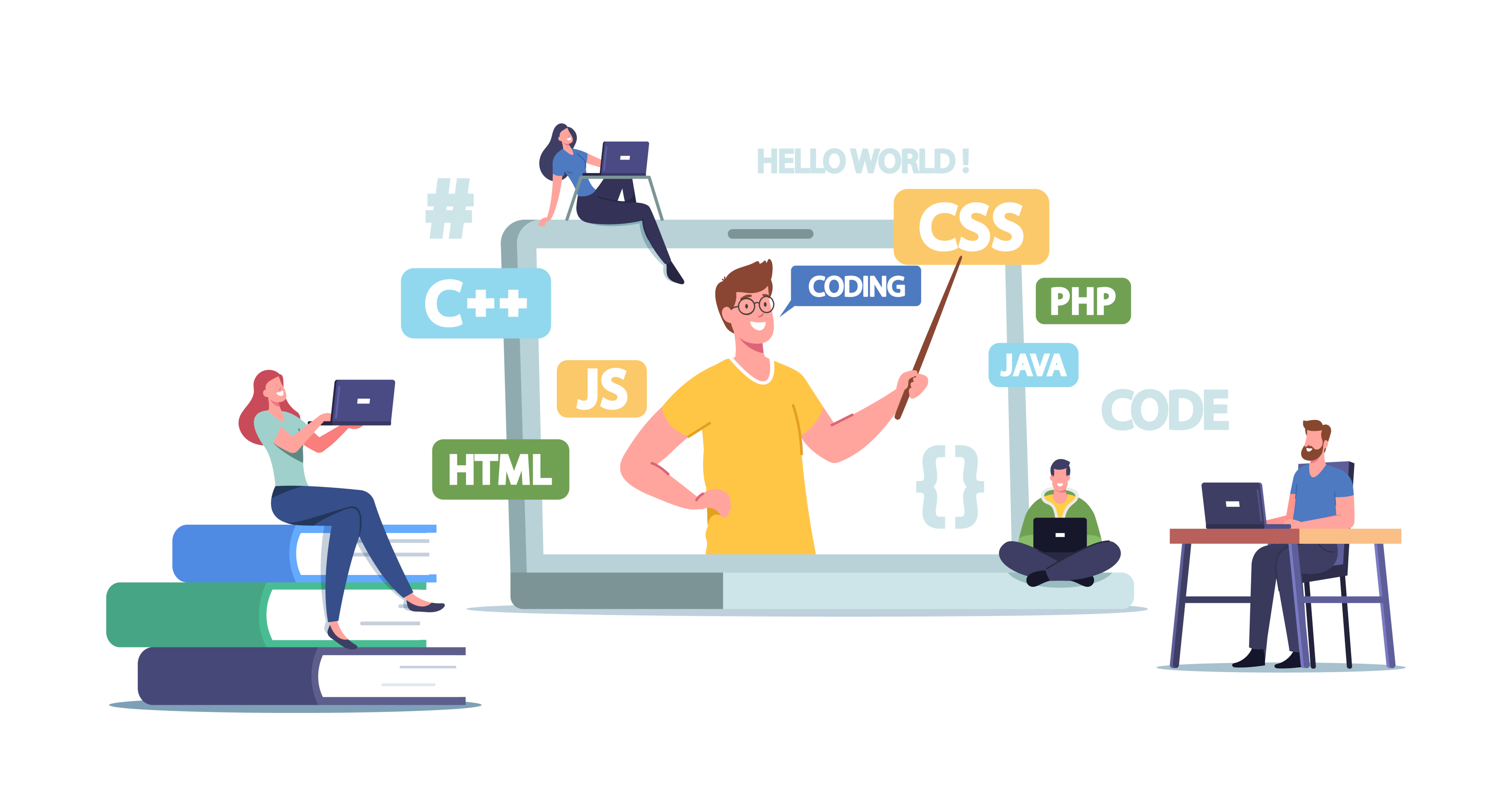
“Which stack is the best for my project?” This is a question that everyone has in mind over the discussion for a new project. Choosing the right programming stack is equally important as choosing the best programming languages. Although there are a certain things that should be made sure while selecting the right software development tools.
In this blog, these are the things that we are going to cover. Stick to the end and you will be able to identify the right software development tools for your next project. Everything from the importance of the right development stack to the right questions and factors to consider while selecting the technical stack will be covered in this blog. This is the one stop solution to all your technical needs in a project.
Importance of Right Programming Languages

In the ever-evolving landscape of technology, the selection of the top programming languages for your project is not just a matter of convenience but a strategic decision that can determine the project’s success. Let’s explore why this choice carries significant weight.
Optimized Performance
The choice of programming languages directly impacts the performance of your application. Certain languages are optimized for specific tasks. For instance, if you’re building a high-frequency trading system, using languages like C++ or Java, known for their speed, is crucial. On the other hand, if you’re developing a data analysis tool, Python’s efficient libraries can be a game-changer.
Development Speed
The best software development tools can significantly accelerate development. Consider this: for a web application, using a language like JavaScript with frameworks like React or Angular can speed up front-end development. Similarly, using Ruby on Rails for back-end development can lead to rapid prototyping and quicker product launches.
Scalability and Future-Proofing
Your choice of language impacts how easily your project can scale as it grows. For instance, if you’re developing a microservices-based application, a language like Go, designed for scalability, can be a wise choice. Likewise, if you’re considering long-term support, opt for languages with strong communities and continuous updates.
Cost Efficiency
Consider the financial implications of your language choice. Open-source languages often require fewer licensing costs and can save significant resources. For example, PHP is a cost-effective choice for web development due to its open-source nature.
Team Productivity
The proficiency of your software development teams in a particular language can significantly affect productivity. A team familiar with a language can work more efficiently and produce higher-quality code. For instance, if your team has expertise in Python, it makes sense to leverage that knowledge for data analysis projects.
Best Programming Languages

In the ever-evolving world of development, choosing the right software development tools is pivotal. Each language comes with its unique strengths, making it more suitable for specific use cases. Let’s dive into some of the most popular software development tools and their standout features.
Python
Main Features of this software development tool:
- Readability: Python is renowned for its clean and easily readable syntax, making it an excellent choice for beginners and experienced software developer alike.
- Extensive Libraries: The Python ecosystem boasts a wealth of libraries, such as NumPy, Pandas, and TensorFlow, which make it a prime candidate for data analysis and machine learning.
- Scientific Computing: Python’s libraries, like SciPy and Matplotlib, empower scientists and researchers to perform complex mathematical and scientific computations.
- Prototyping: Its simplicity and quick development capabilities make Python ideal for prototyping and turning concepts into functioning applications.
JavaScript
Main Features of this software development tool:
- Front-End Development: JavaScript is the cornerstone of front-end web development, allowing software developer to create interactive and dynamic web pages.
- Rich Ecosystem: The JavaScript ecosystem includes popular libraries and frameworks such as React, Angular, and Vue.js, that enables software developer to create complex web applications and responsive websites.
- Cross-Platform Compatibility: JavaScript runs in web browsers, enabling consistent user experiences across different devices and platforms.
- Asynchronous Programming: JavaScript excels in handling asynchronous tasks, a crucial feature for modern web applications.
Java
Main Features of this software development tool:
- Enterprise Software: Java is renowned for its stability, security, and scalability, making it a top choice for developing enterprise-level software applications.
- Android Development: Java is the official software development tool for Android app development, allowing software developer to create apps that run on a multitude of devices.
- Large-Scale Web Applications: With Java Enterprise Edition (EE), developers can create large-scale, robust web applications that can handle high traffic loads.
- Cross-Platform Compatibility: Java’s “Write Once, Run Anywhere” philosophy ensures compatibility across various operating systems.
Ruby
Main Features of this software development tool:
- Web Development with Ruby on Rails: Ruby, in combination with the Ruby on Rails framework, provides a integrated development environment for developing web applications.
- Prototyping: Ruby’s elegant and concise syntax makes it an excellent choice for quickly prototyping ideas and concepts.
- Startups: Many successful startups, such as Airbnb and GitHub, have leveraged Ruby on Rails for its agility and development speed.
C++
Main Features of this software development tool:
- Systems Programming: C++ is ideal for low-level system programming, where precise control over hardware resources is crucial.
- Game Development: Many high-performance games, including AAA titles, are developed using C++ due to its speed and resource control.
- Performance-Critical Applications: When raw computational power and efficient memory management are essential, C++ is the go-to choice.
Go (Golang)
Main Features:
- Server-Side Development: Go (Golang) is designed for building efficient, high-performance server-side applications. Its strong standard library simplifies network and web development.
- Distributed Systems: Go’s built-in support for concurrency and its simplicity make it a solid choice for developing distributed systems and microservices.
- Scalability: Go’s performance and efficiency in handling concurrent tasks make it a prime candidate for projects that require scalability.
By understanding the distinctive features and strengths of these software development tools, you can make an informed choice based on the specific requirements of your project.
Whether you prioritize readability, scalability, or performance, there’s a software development tool that aligns with your development goals.
Factors That Shape Programming Language Choices

In the realm of software development, selecting the right programming language is a strategic decision akin to choosing the right tool for a specific job.
The choice of a programming language has far-reaching consequences, influencing the development process, performance, and long-term maintenance of a software project. Let’s delve into the critical factors that influence this decision-making process to choose the right development company:
Cost Efficiency
Cost plays a pivotal role in programming language selection. The size and scope of a project directly impact development costs. Large projects may necessitate the employment of numerous software developers, resulting in high contracting costs.
Furthermore, long-term maintenance to ensure the software remains error-free and up-to-date adds to the financial burden. However, some programming languages can significantly reduce development costs due to their ease of use, rapid development, and streamlined maintenance.
Organizational Policy
Large organizations often dictate the use of specific programming languages, hardware, and software. Organizational policies are designed to maintain standards and system consistency.
Compliance with these policies ensures equal competitiveness in certain areas while allowing uniqueness in others. Adherence to these policies simplifies planning for future maintenance and updates.
Availability of Tools and Features
A programming language’s availability of tools and features directly impacts development speed and code sustainability. Having the right tools can streamline the production process and enhance the maintainability of code.
However, the features should align with project requirements. Some languages lack multi-platform capabilities, limiting their availability.
Reliability and Stability
Reliability is a critical factor. Some programming languages include features to prevent crashes. Before choosing a programming language, consider how easily it can be fixed in the event of a crash.
While more reliable languages may come at a higher cost, their stability can be worth the investment in the long run.
Suitability for the Project
Suitability is paramount. A programming language must be capable of working on all the platforms your project will use. It should also support multiple users concurrently. Failure to confirm suitability can result in time and money wasted on adjustments.
Scalability and Performance
The choice of programming language can significantly impact the performance and scalability of your project. Some languages are more adept at handling large numbers of users without crashing. For interactive websites or applications, a language with strong scalability features is crucial.
Specific Language Uses
Programming languages have specific uses in different domains such as:
Operating Systems
Operating systems like Windows, Mac, and Linux employ specific programming languages for different components. Windows primarily uses C, while Linux and Mac utilize Kernel.
Websites
HTML is a fundamental language for websites, allowing full control over webpages. PHP and JavaScript serve different functions in web development, with PHP processing on the server side and JavaScript on the client side.
Mobile Applications
Objective-C is common for Apple mobile applications, as it integrates well with iOS devices. Java is preferred for Android application development, offering cross-platform compatibility.
As per the programming language trends, understanding the factors influencing their selection is crucial for making informed decisions.
By considering cost, organizational policies, tool availability, reliability, suitability, scalability, and specific language uses, you can ensure that your chosen programming language aligns with your project’s unique requirements and objectives.
Key Questions for Discussing the Technical Stack

In the area of development, the choice of best software development tools is a critical decision that can profoundly impact the success of your project. By asking the right questions during the planning phase, you can ensure that the technical stack aligns with your project’s unique requirements and objectives.
1. What Are the Specific Goals of the Project?
The project’s objectives form the cornerstone of your technical stack selection. A deep understanding of these goals is crucial for choosing best software development tools that will efficiently and effectively support the project.
Why Ask: Each project has its own set of objectives, whether it’s developing a web application, a mobile app, or an internal tool. The technical stack should be tailored to meet these specific goals.
For example, a content-heavy website may benefit from a robust content management system (CMS) like WordPress, while a data-intensive application may require specialized database management.
2. What Is the Project’s Scalability Requirement?
Scalability needs vary from project to project. Whether your application is a potential hit with millions of users or a small internal tool, the chosen technical stack must support the project’s growth without introducing unnecessary complexity.
Why Ask: Scalability determines how well your application can handle an increase in users or data volume. If you anticipate rapid growth, selecting a stack that can easily scale horizontally (add more servers) or vertically (upgrade server hardware) is vital. This prevents performance bottlenecks as your user base expands.
3. What Is the Project’s Budget and Timeline?
Budget and timeline constraints can significantly influence your choice of software development tools. Some languages, frameworks, and tools may accelerate development but come at a higher cost.
Why Ask: Balancing budget and timeline is critical for project success. Fast development can be advantageous, but it may involve purchasing licenses or subscriptions for premium tools or frameworks. Conversely, open-source technologies may save costs but can sometimes lengthen development timelines due to customization.
4. What Is the Proficiency of Software Development Teams?
Leveraging your team’s skills is key to efficient software development process. Selecting software development tools that your team is well-versed in reduces the learning curve and enhances productivity.
Why Ask: The expertise of software developers is a valuable resource. Using languages and frameworks they are proficient in can streamline development and reduce the risk of errors. It also boosts team morale and motivation, as they can work with confidence and efficiency.
5. What Is the Security and Data Privacy Requirement?
Importance: Security is paramount in today’s digital landscape. The technical stack must align with the project’s security and data privacy needs.
Why Ask: Data breaches and cyber threats are significant concerns. By assessing your project’s security requirements, you can choose technologies with built-in security features or select frameworks and libraries that have established security practices. This helps protect sensitive data and maintain user trust.
6. Is Cross-Platform Compatibility Required?
Importance: In a multi-device world, cross-platform compatibility is often a necessity. Technologies that support cross-platform development can save time and resources.
Why Ask: If your project needs to run on various platforms such as web, mobile, and desktop, selecting technologies that enable cross-platform development is crucial. This approach ensures a consistent user experience and simplifies code maintenance across different devices.
7. What Are the Long-Term Maintenance and Support Requirements?
Importance: For the long-term success of your project, consider technologies with active communities and ongoing updates. Neglected technologies can lead to maintenance challenges and security vulnerabilities.
Why Ask: Software projects require continuous maintenance, updates, and bug fixes. Selecting technologies with active developer communities ensures that you have access to ongoing support, updates, and a wealth of resources. This prevents your project from becoming obsolete or vulnerable to security threats.
8. What Are the Performance and Speed Expectations?
Importance: Performance requirements vary depending on the application. High-performance and speed are essential for some projects, while others can achieve their goals with more high-level languages.
Why Ask: The choice of technical stack directly affects the speed and efficiency of your application. For performance-critical applications, selecting low-level languages like C++ or Go can optimize performance. In contrast, high-level languages like Python may be suitable for data analysis and prototyping where performance is not the top priority.
9. Are There Third-Party Integrations?
Many projects rely on third-party integrations, such as payment gateways or APIs. Your technical stack should easily accommodate these connections.
Why Ask: Third-party integrations can expand the functionality of your application, but they require compatibility with your technical stack. Ensure that the chosen technologies can seamlessly interact with these integrations, preventing integration-related issues and improving user experience.
10. How Will Testing and Quality Assurance Be Handled?
Importance: A robust testing strategy is essential to ensure the quality and reliability of your software. It’s vital to consider how well your chosen technologies support testing and quality assurance processes.
Why Ask: Effective testing and quality assurance are critical for delivering bug-free and reliable software. Some languages and frameworks offer robust testing libraries and tools, making it easier to maintain code quality and identify and fix issues early in the development process.
Conlusion
In the dynamic landscape of software development process, the selection of the right programming tools and technical stack stands as a cornerstone of project success.
As we’ve explored in this comprehensive guide, the choices you make at this stage have far-reaching consequences, impacting everything from performance and scalability to cost efficiency and long-term maintenance.
The importance of selecting the best software development tool and software development platform cannot be overstated. It determines the very foundation upon which your project will stand.
Whether optimizing for performance, enhancing development speed, or ensuring the security and privacy of your application, each decision is a strategic move in the chess game of software development.



